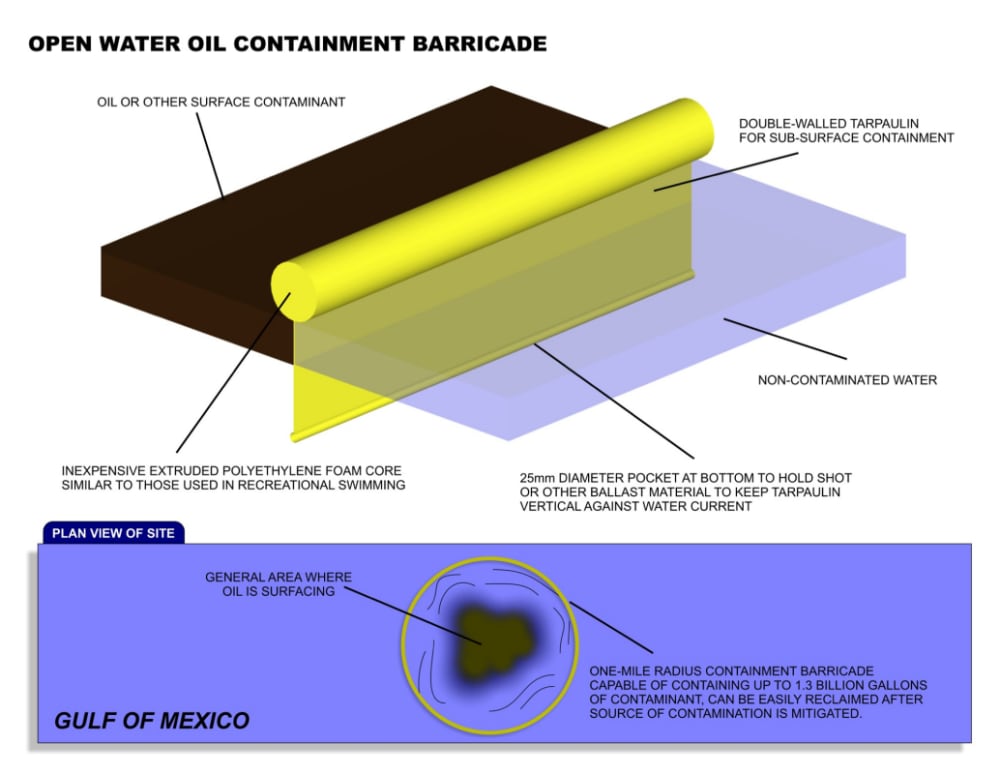Problem:
Offshore oil rigs can rupture and cause serious, perhaps irreparable damage to coastal areas and the
commercial fishing industry. As indicated by recent events in the Gulf of Mexico, no method is
currently in place to prevent the spread of such contamination.
Current methods rely on burning surface oil off into the atmosphere, or using chemical dispersants to
bind with the oil and sink it. Both of these approaches have a serious negative environmental impact.
Solution:
The Open Water Oil Containment Barricade is a simple circular extrusion of polyethylene foam
encased in a sheet of tarpaulin material, with sufficient excess material to form a curtain. The foam
floats on the surface and the curtain descends into the water, held vertical by a ballast pocket at the
bottom. Since the specific gravity of oil causes it to float, the barricade provides an impenetrable wall
both above the surface and 2 feet below the surface to contain it.
A small one mile radius protection zone around the surfacing area could contain 1.3 billion gallons of
oil, or about 65 times the amount thus far produced by the present (based on USGS estimate of 500,000
gallons per day) as of this writing. Such a containment ring would consist of 6.28 miles of barricade.
At an estimated cost of $30 per linear foot (very conservatively), the ring would cost roughly $1
million USD.
Benefits:
• Cleanup and recovery
Containing the oil not only prevents it from contaminating coastal areas, fish, birds, and other wildlife,
it provides a simplified method to actually recover the lost oil. Simple vacuum systems can easily
siphon the oil back onto tankers, gradually reducing the diameter of the barricade to keep the density
high during collection. There is no need to use dispersant or to burn the oil at the surface.
• Flexibility
If need be, the containment ring can easily be spliced into to expand the radius of the containment zone.
The reverse is also true, sections of the material can be removed as the spilled oil is recovered. Also, it
can be deployed quickly to contain spills before they spread.
• Inexpensive insurance (Possibly government-mandated)
The government can and should require any permitted offshore oil operation to purchase and maintain
such containment barricades for every rig it operates within range of its coastline.
Summary:
The proposed solution is inexpensive, easily deployable, and can save countless billions of dollars from
lost revenue (fishing, tourism, environmental cleanup, and many other ancillary costs involved) as well
as preventing harm to delicate coastal wildlife. The present crisis will have repercussions for decades,
and the chemical dispersants used will cause untold damage to all aquatic life in the gulf.
This barricade design will not only prevent the damage, but allow the company to reclaim the lost
product, providing benefits to everyone involved.
Like this entry?
-
About the Entrant
- Name:John Nagle
- Type of entry:individual
- Hardware used for this entry:Dell XPS M1730 laptopSoftware used for this entry:Google Sketchup, Xara
- Patent status:none

